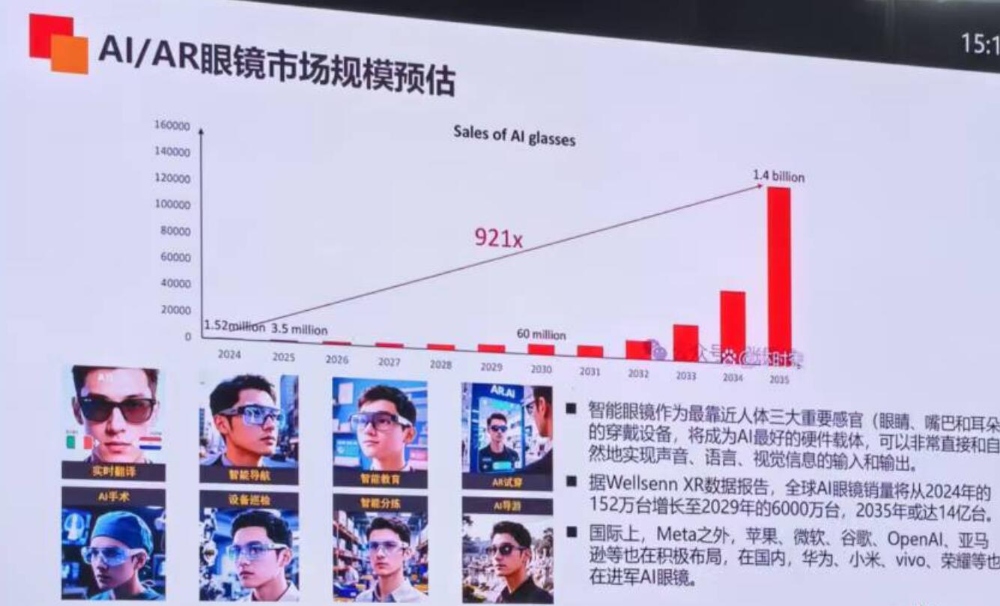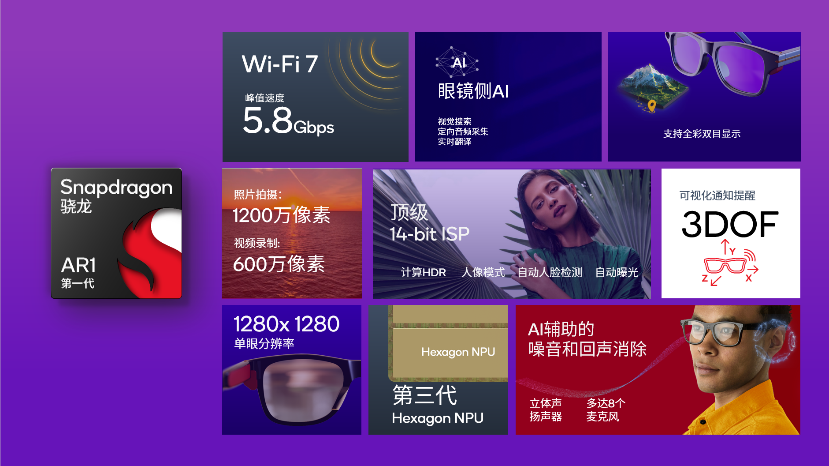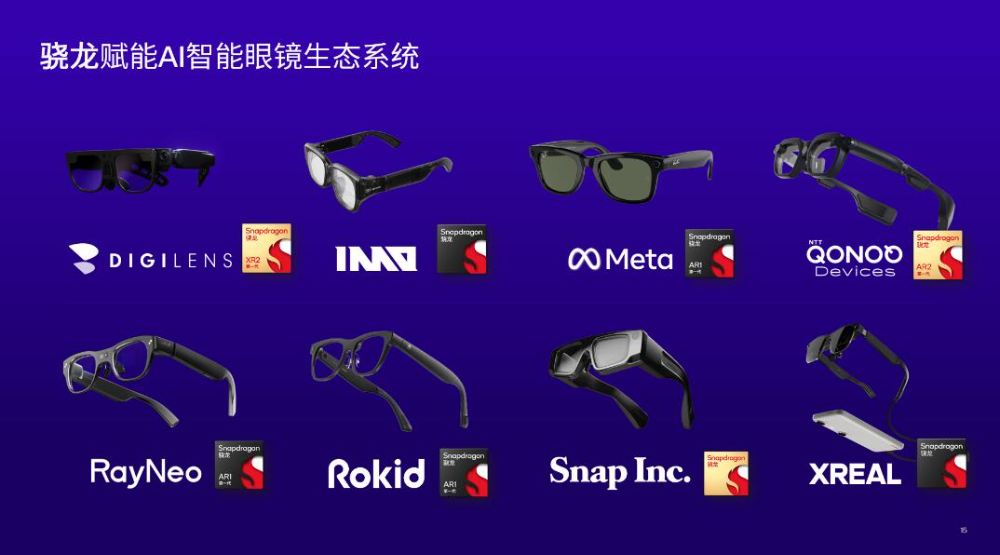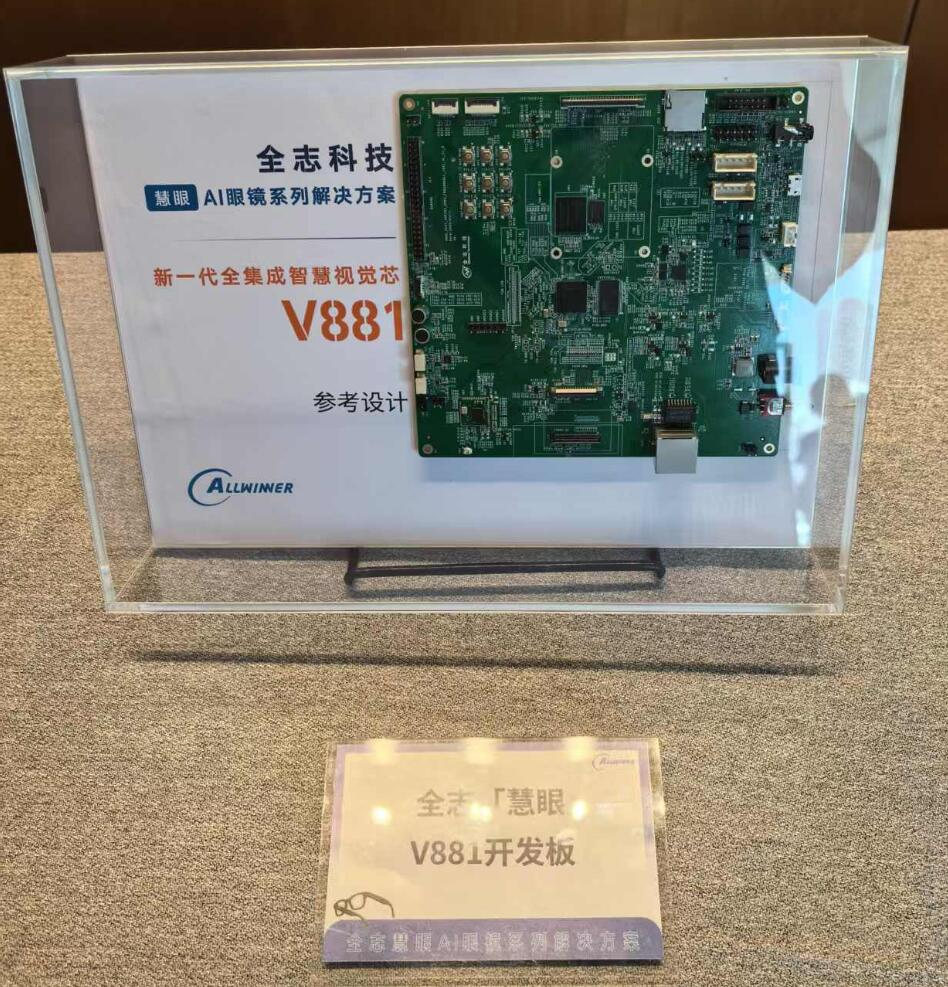According to reports from Electronic Enthusiasts (by Zhang Ying), the smart glasses market is experiencing a surge. On May 20, Google announced its Android XR smart glasses, which compete with Meta, during the Google I/O keynote. These glasses come equipped with built-in cameras and microphones, allowing Germini to “see” and “hear” the world. The XR smart glasses can perform real-time translation and video calls. Screenshot of smart glasses from Google I/OOn May 25, Li Weike launched new smart glasses, introducing the Li Weike View AI glasses, City Air AI glasses, and a fashionable version of City AI glasses. Among them, the Li Weike View AI glasses weigh 38g and can perform four major AI functions: AI selfie, AI instant capture, AI portable recording, and AI real-time translation.According to Wellsenn XR data, global sales of AI glasses are expected to reach 1.52 million units in 2024, increasing to 3.5 million units in 2025, potentially exceeding 60 million units by 2029, and reaching 1.4 billion units by 2035. Smart glasses have evolved from laboratory equipment to essential wearable devices that integrate AI and augmented reality, with an increasing number of players in the main control chip market.
Screenshot of smart glasses from Google I/OOn May 25, Li Weike launched new smart glasses, introducing the Li Weike View AI glasses, City Air AI glasses, and a fashionable version of City AI glasses. Among them, the Li Weike View AI glasses weigh 38g and can perform four major AI functions: AI selfie, AI instant capture, AI portable recording, and AI real-time translation.According to Wellsenn XR data, global sales of AI glasses are expected to reach 1.52 million units in 2024, increasing to 3.5 million units in 2025, potentially exceeding 60 million units by 2029, and reaching 1.4 billion units by 2035. Smart glasses have evolved from laboratory equipment to essential wearable devices that integrate AI and augmented reality, with an increasing number of players in the main control chip market. Image: AI/AR glasses market scale captured by Electronic EnthusiastsThis article will focus on the chip products and solutions for smart glasses from Qualcomm, Allwinner Technology, STMicroelectronics, and Starry Technology.
Image: AI/AR glasses market scale captured by Electronic EnthusiastsThis article will focus on the chip products and solutions for smart glasses from Qualcomm, Allwinner Technology, STMicroelectronics, and Starry Technology.
Qualcomm’s 4nm Snapdragon AR1, One of the Mainstream Platforms for Smart Glasses
As early as September 2023, Qualcomm announced the launch of two new spatial computing platforms—the second-generation Snapdragon XR2 and the first-generation Snapdragon AR1, which will support the development of next-generation leading MR, VR, and smart glasses devices. In 2024, the Ray-Ban Meta smart glasses, which are expected to ship over a million units globally, will be equipped with the Qualcomm AR1 Gen1 chip, making it the first smart glasses to integrate Meta AI.The Ray-Ban Meta smart glasses feature a 12-megapixel camera, support 60 seconds of 1080P 60fps video recording, and can capture photos with a maximum resolution of 3024 x 4032 pixels. Compared to the first-generation Ray-Ban Stories, which had a 5-megapixel camera and recorded video at 1184 x 1184 resolution at 30fps, the image quality of this generation has significantly improved. Qualcomm stated that this platform is uniquely designed and optimized for thermal limitations in terms of power consumption, supporting the creation of stylish and lightweight smart glasses with an excellent experience. The first-generation AR1 platform supports 12-megapixel photo capture and 6-megapixel video recording; it features Wi-Fi 7 capabilities with peak speeds of 5.8Gbps; and includes AI capabilities for visual search, directional audio capture, real-time translation, and more. Additionally, the chip’s 14-bit ISP provides various functions such as computational HDR, portrait mode, automatic face detection, and automatic exposure.On May 27, TCL’s Thunderbird officially launched the X3 Pro AI glasses with a custom large model and full-color display, priced at 7649 after national subsidies (original price 8999). The Thunderbird X3 Pro is equipped with the 4nm Qualcomm Snapdragon AR1 platform and supports waveguide full-color display, weighing only 76g.
Qualcomm stated that this platform is uniquely designed and optimized for thermal limitations in terms of power consumption, supporting the creation of stylish and lightweight smart glasses with an excellent experience. The first-generation AR1 platform supports 12-megapixel photo capture and 6-megapixel video recording; it features Wi-Fi 7 capabilities with peak speeds of 5.8Gbps; and includes AI capabilities for visual search, directional audio capture, real-time translation, and more. Additionally, the chip’s 14-bit ISP provides various functions such as computational HDR, portrait mode, automatic face detection, and automatic exposure.On May 27, TCL’s Thunderbird officially launched the X3 Pro AI glasses with a custom large model and full-color display, priced at 7649 after national subsidies (original price 8999). The Thunderbird X3 Pro is equipped with the 4nm Qualcomm Snapdragon AR1 platform and supports waveguide full-color display, weighing only 76g. It is reported that in addition to the Meta Ray-Ban smart glasses, several partners including Thunderbird, XREAL, Yingmu Technology, and Hangzhou Lingban Technology (Rokid) have launched smart glasses equipped with the AR1 platform. Qualcomm’s announcement indicates that the Snapdragon platform has empowered partners to release over 100 XR terminals.
It is reported that in addition to the Meta Ray-Ban smart glasses, several partners including Thunderbird, XREAL, Yingmu Technology, and Hangzhou Lingban Technology (Rokid) have launched smart glasses equipped with the AR1 platform. Qualcomm’s announcement indicates that the Snapdragon platform has empowered partners to release over 100 XR terminals.
Allwinner Technology Launches V821 to Empower Smart Glasses, V881 Expected in Q3
On May 16, during the Allwinner Technology AI Glasses Series Solutions Launch Conference, Chen Zhixiang, Deputy General Manager of Allwinner Technology’s Smart Video Division, stated that in response to the demand in the smart glasses market, Allwinner Technology has launched the V821 chip and solution.
 Image: V821 prototype, captured by Electronic EnthusiastsThe V821 is a series of highly integrated low-power multi-lens IPC SoCs, utilizing a dual RISC-V architecture processor, supporting real-time access for two cameras. Its internal high-performance ISP and H264 encoding unit provide 4M HD video processing capabilities. The V821 also integrates Wi-Fi4, LDO, Audio codec, etc., offering an extremely cost-effective encoding solution. Based on its excellent ISP processing capabilities, low power consumption, and high expandability, the V821 can be extended to smart glasses, multi-lens IPC, smart locks, and other products.On-site reporters experienced smart glasses equipped with the V821, weighing about 40 grams, capable of taking photos, recording videos, and making calls. Staff indicated that the standby time is approximately 4 hours. Photos and videos taken can be uploaded in real-time to mobile devices via Wi-Fi.
Image: V821 prototype, captured by Electronic EnthusiastsThe V821 is a series of highly integrated low-power multi-lens IPC SoCs, utilizing a dual RISC-V architecture processor, supporting real-time access for two cameras. Its internal high-performance ISP and H264 encoding unit provide 4M HD video processing capabilities. The V821 also integrates Wi-Fi4, LDO, Audio codec, etc., offering an extremely cost-effective encoding solution. Based on its excellent ISP processing capabilities, low power consumption, and high expandability, the V821 can be extended to smart glasses, multi-lens IPC, smart locks, and other products.On-site reporters experienced smart glasses equipped with the V821, weighing about 40 grams, capable of taking photos, recording videos, and making calls. Staff indicated that the standby time is approximately 4 hours. Photos and videos taken can be uploaded in real-time to mobile devices via Wi-Fi. Image: V881 development board, captured by Electronic EnthusiastsChen Zhixiang shared, “The V821 is just the beginning of Allwinner Technology’s entry into the smart glasses market. Today, Allwinner Technology officially launched the V881, which supports up to 4K 30, H265/H264 recording, and high dynamic range anti-shake. The V881 features HDR synthesis, and the chip supports six-axis sensors. The V881 defaults to support 12-megapixel resolution, and the V881 L3-WXX will reduce the custom size to 6Xmm * 11.xmm, supporting dual-band WiFi6. Memory has been upgraded from DDR2 to DDR4, with download transfer rates increased by 400%, capacity increased by 100%, speed increased by 75%, and power consumption set at 300-400 milliwatts. We expect to deliver to customers by the third quarter.”
Image: V881 development board, captured by Electronic EnthusiastsChen Zhixiang shared, “The V821 is just the beginning of Allwinner Technology’s entry into the smart glasses market. Today, Allwinner Technology officially launched the V881, which supports up to 4K 30, H265/H264 recording, and high dynamic range anti-shake. The V881 features HDR synthesis, and the chip supports six-axis sensors. The V881 defaults to support 12-megapixel resolution, and the V881 L3-WXX will reduce the custom size to 6Xmm * 11.xmm, supporting dual-band WiFi6. Memory has been upgraded from DDR2 to DDR4, with download transfer rates increased by 400%, capacity increased by 100%, speed increased by 75%, and power consumption set at 300-400 milliwatts. We expect to deliver to customers by the third quarter.”
ST Launches AI MCU, Supporting Lightweight and Long-lasting Smart Glasses
At the recent Munich Shanghai Electronics Show, ST showcased the MoJie AR glasses, weighing only 35 grams, making them the lightest dual-lens AR glasses in the world, capable of achieving 10 hours of battery life.How does this pair of glasses achieve a balance between low power consumption and high performance? Ding Xiaolei, Marketing Manager of STMicroelectronics’ Microcontroller, Digital IC, and RF Products Division in China, stated that the MoJie AI glasses are based on the STM32 N6 core, which matches the characteristics of lightweight AR glasses and supports advanced perception and interactive functions. These functions require low power consumption, minimal computational load, and almost zero latency, such as SLAM, gesture control, and eye-tracking functions, and are integrated with generative artificial intelligence, leading to many innovative applications.The STM32N6 is STMicroelectronics’ first STM32 MCU embedded with a self-developed neural processing unit (NPU)—the ST Neural-ART accelerator™, designed for energy-efficient edge AI applications. This product has a clock frequency of up to 1 GHz and a computing performance of up to 600 GOPS, providing real-time neural network inference capabilities for computer vision and audio applications.The low power performance of the STM32N6 chip is outstanding. The product is based on an MCU architecture, which allows for lower power consumption compared to SoC architecture. The chip supports two power supply modes of 1.8V and 3.3V, with a preference for 1.8V for wearable products, allowing for power savings.
Starry Technology Launches SSC309L, Empowering Innovation in Smart Glasses
As a global leader in smart security chip design, Starry Technology focuses on edge and endpoint AI SoC chips as its core competitiveness, continuously deepening its AI technology layout and building a full industry chain ecosystem covering “chip + algorithm + application.”In the smart glasses sector, Starry Technology has developed a small-sized, low-power, lightweight intelligent image processing chip, the SSC309L, specifically for smart glasses. Leveraging its professional-grade image processing technology, the company has launched the SSC309QL high-integration solution based on Chiplet architecture—integrating LPDDR4 (2Gb) storage units to reduce chip area and decrease video recording power consumption. Coupled with a low-power architecture design that coordinates hardware and software, the SoC’s operating power can be as low as 30mW, achieving an “all-day recording” experience.The SSC309L uses the company’s self-developed image processing engine ISP4.0, with a photo capability of up to 12M, supporting dual channels and a series of advanced technologies such as 3A, HDR, WDR, and 3DNR. In terms of video encoding, it can achieve 4K@30 H.264/H.265 format output. This chip has a computing power of 1.5T, enabling local low-power intelligent applications.On April 30, Starry Technology stated at its performance briefing that the company has been strategically laying out in the smart wearable field for a long time. It has now launched the SSC309QL SoC chip suitable for AI glasses, with customer terminal products expected to ship in the second half of 2025.

Disclaimer:This article is original from Electronic Enthusiasts and must be cited as the source. For group discussions, please add WeChat elecfans999, for submission of reports or interview requests, please email [email protected].
More Hot Articles to Read
-
Haiguang “Swallows” Zhongke Shuguang, Domestic Computing “Super Aircraft Carrier” Sets Sail!
-
IT Jobs Are Collapsing! Claude 4 Shocking Release: AI Programming Large Model Evolves Again
-
Exhibition Highlights: Drones Dazzle, Chips Positioning for Low-altitude Economic Explosion
-
Exhibition Highlights: From AI Glasses to AI Toys, Workers’ Equipment + Childcare Tools Debut
-
Xiaomi’s Self-developed 3nm Flagship SoC and 4G Baseband Debut! Lei Jun Reflects on 11 Years of Chip Development
Click to Follow and Star Us
Set us as a star to not miss any updates!